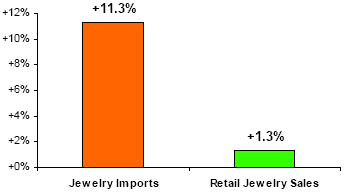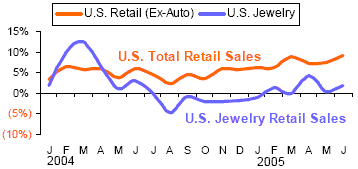IDEX Online Research: Has 'Irrational Exuberance' Overtaken the Jewelry Industry?
September 28, 05
Diamond and jewelry suppliers have been bragging all year about how good business is. Shipments to merchants are up substantially over last year, they say. Further, the suppliers claim that retail sell-through appears strong.
The problem is that the current retail sales numbers don’t support this level of optimism in the U.S. market.
- For the first six months of 2005, the U.S. International Trade Commission reported that the value of jewelry imported into the U.S. had risen a whopping 11.2% over the same period in 2004.
- In dramatic contrast, the U.S. Department of Commerce reported that jewelry sales in the U.S. are up a meager 1.3% for the first six months of 2005.
- IDEX research estimates that supplier shipments of all jewelry (both domestically produced and imported) to U.S. retailers may be up in the range of 7-9% so far this year.
Based on these statistics, the diamond and jewelry pipeline is rapidly becoming clogged. With increased uncertainties looming in the U.S. market – primarily a potential economic slowdown from the fallout of Hurricane Katrina and disrupted oil supplies – suppliers who have been banking on a solid holiday selling season may be disappointed.
| U.S. Jewelry Imports & Retail Sales |
Jewelry Retail Sales Trends
For the first six months of 2005, the U.S. Department of Commerce reports that jewelry sales through specialty retailers rose a very modest 1.3% over the prior year. Further, demand for jewelry has substantially lagged most other retail categories so far in 2005. Jewelry’s 1.3% gain pales against a solid 7.3% gain for all U.S. retail sales (less food and autos). The graph below illustrates current jewelry demand trends versus total retail sales in the U.S.
| Jewelry Sales vs Total US Retail Sales |
While the first six months of the calendar year represent only just over one-third of a typical jeweler’s annual sales (a second one-third of sales comes in the next four months, and the final one-third of a jeweler’s annual sales come in November and December), the current demand trends are not encouraging enough to warrant the level of optimism that appears to have engulfed the jewelry industry.
Further, even before Hurricane Katrina blew through petroleum-producing Gulf states, consensus forecasts were calling for a modest slowing of both global and U.S. economic growth in the second half of 2005. Jewelry demand tracks very closely with growth of Gross Domestic Product (GDP), especially in the U.S.
Chain jewelers’ sales have shown solid gains in the first half of 2005, well above the industry average. For the six major publicly held chains, total sales climbed by about 7%, dramatically above the industry average of 1.3%. Annual sales from these six chains represent about 15% of industry sales. A quick mathematical calculation suggests that first half sales for the balance of the industry’s jewelers – representing about 85% of total specialty jewelry sales – were about flat.
Jewelry Supply Trends
Reports from this spring’s jewelry shows indicate that demand for jewelry from retailers has been strong. IDEX’s report from the June Las Vegas show brimmed with enthusiasm and optimism: “The JCK Vegas show was booming. Aisles were packed, customers were actually waiting in line for many exhibitors, and all indications bode well for a strong 2005/06 season.”
For the first half of 2005, the USITC reports that jewelry imports (by value) are up 11.3% over the same period last year. This is nearly nine times as great as the sales gain (by value) at the retail level.
Further, reports coming from supplier countries indicate that jewelry and diamond exports to the U.S. have generally been strong. While Israel’s exports to the U.S. are down about 2% year-to-date and Belgium is about flat, India’s numbers suggest that exports of polished diamonds to the U.S. are up mid-single digit.
While there are only a few suppliers who report their results publicly, results so far indicate healthy gains. For example, De Beers reported that DTC diamond sales advanced by a robust 7.9% for the first half of 2005. Further, the DTC is predicting a 6% increase in diamond demand in the second half of 2005.
Lazare Kaplan’s revenues doubled in the first half of 2005. Aber Diamond’s mining revenues were up by about 42% in the first half versus the same period last year.
A Choked Pipeline Looms
Where is all of this merchandise going? Are retail jewelers peddling it out the back door for cash?
Some suppliers have argued that jewelers are re-stocking after a strong holiday season in 2004 and solid sales so far this year. Again, referring to the graph above, the numbers don’t support this supposition.
More likely, it is a combination of two factors:
- Retailers who are re-stocking, but really don’t understand how to control inventory levels (this represents most of the mom-and-pop independent jewelers in America)
- Retailers who are expecting a strong holiday season for 2005.
Our view is different: there is no way U.S. retail jewelers can absorb the large volume of incoming merchandise without putting a chokehold on the inventory pipeline later this year.

